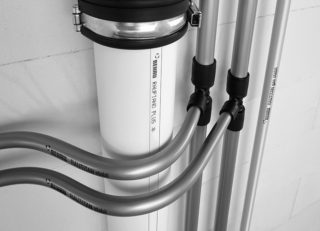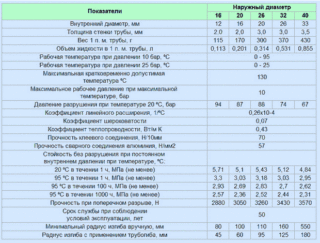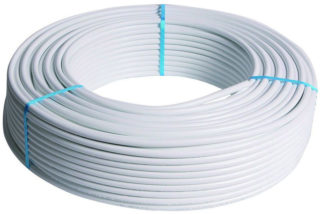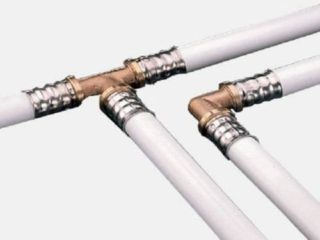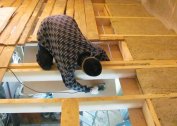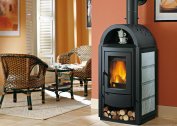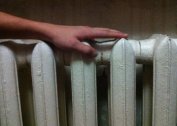Iron is less and less in demand in the laying of domestic and industrial communications. The era of steel pipes, due to their inherent minuses, is gradually ending. They are replaced by metal-plastic pipes, which practically have no shortcomings, differing in numerous positive characteristics. The idea of using metal-plastic for heating is attractive in many ways, including for self-assembly.
The construction of plastic pipes
Products are not an alloy of several types of raw materials, they are multilayer structures, where each element performs a specific task.
Metal-plastic has the following structure:
- Crosslinked polyethylene or polypropylene. It forms an internal smooth surface, due to which free flow of liquid is ensured. The material is durable, flexible, resistant to temperature extremes.
- An adhesive composition that has the same coefficient of thermal expansion as the reinforcing component.
- Aluminum tube. The walls of the metal are welded butt or lap. Metal gives products strength, dimensional stability and protection of polyethylene from contact with oxygen.
- Another layer of bonding agent.
- High pressure polyethylene. Plastic is durable and flexible. Provides protection of internal elements from mechanical damage.
Thanks to this design, pipes made of metal-plastic for heating are able to withstand high pressure and strong heating without loss of performance.
Advantages and disadvantages
Compared to products made from other materials, the glued combination of plastic and aluminum has the following advantages:
- lack of special conditions for transportation and storage;
- ease of installation;
- sound absorption;
- low specific gravity;
- resistance to corrosion, fungus and mold;
- environmental Safety;
- shape retention during temperature changes;
- reliability and tightness of connections;
- presentable appearance;
- the possibility of laying on top of the finish;
- a wide range of applications, both in private homes and in commercial buildings;
- affordable cost due to automation of the production process and the use of inexpensive raw materials;
- smooth inner surface on which no deposits and deposits are formed;
- long service life (at least 50 years).
However, even high-quality Rehau metal-plastic pipes have such disadvantages:
- when in contact with a flame, plastic ignites and releases toxic substances;
- narrow range of working temperatures;
- the material melts when heated above 130 degrees;
- limited diameter, maximum cross-sectional size is 63 mm;
- narrowing of the channel at the joints, which leads to a decrease in the speed of movement of water;
- the need for periodic tightening of crimp fittings, which makes it impossible to make a hidden laying of the pipeline.
A metal-plastic pipe is a material excellent in technical respects, which can significantly save energy and money when arranging communications for various purposes.
Marking of plastic pipes
Marking on pipes is a decoding of the method of their production, composition and technical characteristics.The values are applied in black ink using an automated printer at the final stage of production. The inscriptions go along the entire length of the product, it is not difficult to find them.
Marking symbols have the following meanings:
- PE-R - polyethylene;
- PP-R - polypropylene;
- PE-X is crosslinked polyethylene at the molecular level.
In turn, stitching methods are indicated by the following letters:
- a is peroxide;
- b is a silane;
- c is the flux of directed electrons;
- d is the azo compound of molecules.
In addition, the design working pressure (PN) and product diameter are indicated.
Specifications
Main characteristics of MP pipes:
- outer diameter - 16-63 mm;
- the length of one continuous run is 50-200 m;
- the thickness of the aluminum layer is 0.15-0.6 mm;
- allowable bending radius - 50-550 mm;
- coefficient of thermal expansion - 0.026 mm / m per 1 ºC;
- nominal pressure - 10-20 Bar, at a temperature of 95 ºC and 20 ºC, respectively;
- thermal conductivity coefficient - 0.45 W / mK.
The lists are averages. At various manufacturers, they can deviate in one direction or another.
Features of the choice of pipe products from metal
An integral condition for the manufacture of a reliable and durable circuit is the use of high-quality material in the installation.
When buying it, you should pay attention to such aspects:
- Appearance. The cut should be perfectly round, the surface is even and uniform, the marking is clearly applied.
- Dimensions must comply with current standards.
- The thickness of the aluminum layer for equipping the heating system is at least 0.4 mm.
- The reinforcing layer is butt welded. Such products are stronger and easier to bend.
It is recommended to purchase IP products in specialized stores. The original product is completed with accompanying documents from the manufacturer and dealer. Compliance with the rules of material selection eliminates the risk of acquiring a low-grade fake.
Heating installation
Since the heating system contains hot coolant under high pressure, the connections of individual sections of the circuit must be characterized by increased reliability and strength.
There are such docking methods:
- Detachable. Angles, couplings, crosses, adapters are reusable, as they are connected to the thread. Docking is done using nuts, collets and sealing material.
- Pressing. Press fittings make the connection one-piece. Docking is performed by press pliers by installing a fitting and a crimp sleeve. This method is considered the most reliable and durable.
- Compression. The connection is made with the help of a fitting, a compression ring and union nuts. After assembling the structure, it is tightened with a special key. Requires periodic tightening to compensate for plastic shrinkage.
Given the fact that the pipes bend well, you can minimize the number of fittings by bending products using a building hair dryer. The minimum bending radius is indicated in the accompanying documents for the product.
Connection of metal-plastic and metal pipes
The metal-plastic circuit can be diverted from the heating boiler or connected to a common riser. For connection, a special fitting is used, in which one end is equipped with an internal thread, and the second with a sliding washer or press coupling. First, the product is screwed onto a pipe with an external thread, the joint is sealed with FUM tape or tow. After that, the coupling is mounted on a plastic fragment and tightened with a sliding washer. This connection is reliable, but requires regular thread tightening. If necessary, the fitting can be replaced with a more advanced product.

